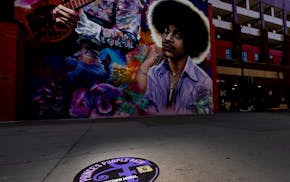On Black Friday we'll be tempted with alluring deals for designer denim and holiday dresses, puffer jackets and fleece leggings. We may already have started to plunk items into our virtual carts, buoyed by the visions of a refreshed wardrobe (at 50% off! Enter code: HURRY!).
Annie Humphrey would invite us to pause before we click to order. The Anishinabe singer-songwriter from Leech Lake Reservation in northern Minnesota, known for her heart-tugging folk music, has recently pivoted to fashion. But not the kind of garments produced by the fast-fashion industry that many of us fuel through our purchases.
Humphrey's style mantra is anything but fast. About a year ago she started applying her sewing skills to upcycle secondhand clothing, adding value with a whimsical or creative twist. She scours thrift stores for quality clothing and customizes the pieces with a cool patch here, a swath of drapery there.
More than a dozen of her favorite reconstructed items have appeared in "sustainable fashion shows" that she and her new arts collective, Fire in the Village, hosts before their live music performances. They'll do it again at the last show of the tour, on Black Friday at the Hook & Ladder Theater in Minneapolis.
"I had a curtain from my bathroom — it was hanging up for 10 years," Humphrey said about one of her creations. "And I thought, this is a beautiful piece of fabric. I should make something."
She started putting her own imprint on secondhand clothing after she heard a story on the radio about an illegal landfill in Chile's Atacama Desert. The mountain of imported and abandoned clothing, hailing from all over Asia, Europe and the United States, is so huge that it's visible from space.
You could say that these piles of fabric, much of it synthetic and not biodegradable, are a symbol of our obsession with new things — and the mindless ease with which we discard them. We Americans buy about five times the amount of clothing than we did in 1980. In the UK, the average piece is worn only seven times before discarded, according to one study.
"We're just consumers. We go through everything," Humphrey said. "It's a disposable society."
OK, so what do you do with a problem as seemingly intractable as mass consumerism that is killing our planet?
One thing I've heard a lot of depressed liberals say after losing this election is that we have to think small. Control what we can. Focus on local communities. Humphrey, an activist and former Marine who says she's started to veer away from talking politics, said we shouldn't dismiss the power of tending the fires in our own backyards. She learned this truth while participating in large-scale environmental protests.
"In my younger years, I would leave home to fight against things. And I remember I was out against the [Line 3 oil] pipeline, and my grandson would say, 'When are you gonna come home?'" she recalled. "And I thought, 'Yeah, what about home?' Everything behind me is where I can make a real difference, and all this stuff out in front of me is so big. So I just came back home. That's where it's at for me."
For Fire in the Village, she's teamed up with public artist Shanai Matteson, musician David Huckfelt and other cultural organizers. The collective visits high schools, mostly in rural northern Minnesota, to promote art, music and community-building, without political affiliations.
"We're not swooping in to create a fire. The fires are already there," Humphrey said. "We just want to lift the spirits of people and inspire them. Our fires will connect, mine to your friends, and from theirs to other places."
At the fashion shows, Fire in the Village recruits models from the crowd on site during an hour of print-making. Word snowballs quickly as those volunteers recruit their friends to model the reimagined garments. The items showcase the beauty of something discarded, and the magic of a second life.
Humphrey's handiwork was honed from years of sewing Ojibwe jingle dresses for the women in her family. She is now in the process of gathering used wedding gowns to host a secondhand bridal expo in the spring.
What advice does the 58-year-old Humphrey have for someone like me? Nary an artisan bone to be found in my body, I can't sew and wouldn't know where to begin to craft clothing that is stylish, let alone wearable.
Thrift, she said. Repair what you can. Invest in quality clothing that will last many years. Look for natural materials, such as cotton, linen and wool. It's OK if you can't sew — start accessorizing with a single patch. And don't forget that individual actions can lead to bigger change.
"People want to do something, but they're not sure how to help," Humphrey said. "This Fire in the Village idea is about staying home and tending to your own fire. You don't have to travel to find a problem. There are things we can help with, right where we are."
Inspired by Humphrey, here's what I did: I removed a few shopping items from my cart. One way we can fight fast fashion is to simply slow down.

Minneapolis native Evren Ozel advances to finals of Van Cliburn International Piano Competition

How many of Minneapolis' new 'Purple Path' sidewalk signs for Prince fans can you find?
![Pepe Willie stood for a portrait outside the Capri Theater, which is undergoing a major renovation, in Minneapolis. ] Shari L. Gross • shari.gross@s](https://arc.stimg.co/startribunemedia/4TPIVGPZLESDCIL3ZJ4J4T4ZDU.jpg?h=91&w=145&fit=crop&bg=999&crop=faces)
Pepé Willie, mentor to Prince and Morris Day, dies at 76

Your ultimate guide to eating and drinking in downtown St. Paul

